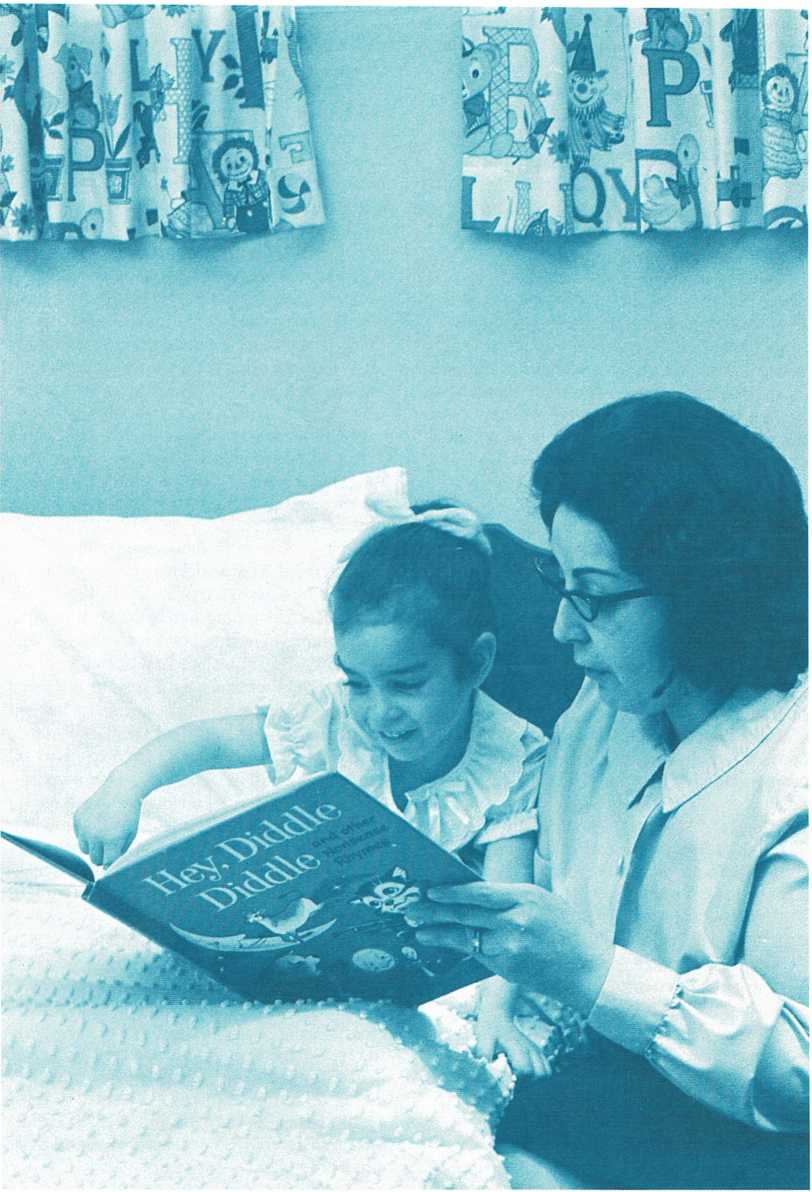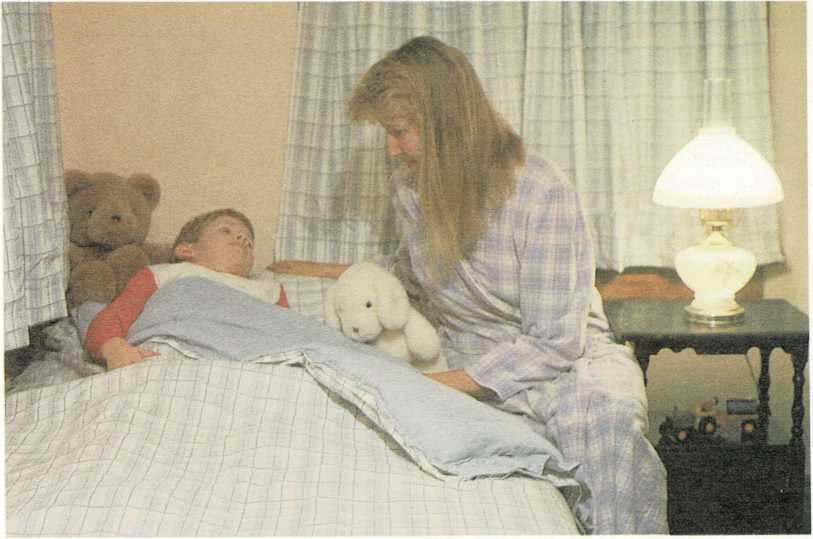Sleep

Most children enjoy having stories read to them at bedtime.
stimulated to a point where both the amount and the quality of sleep
suffer. A child who becomes overtired may resist going to bed and may
have difficulty going to sleep.
Children may use sleep to escape from situations that disturb them.
Dread of school, fear of failure, childhood depression, and fear of
neighborhood bullies can cause a child to resist getting up in the
morning. However, these same fears may make another child sleepless.
Amount of sleep. Newborns need more sleep and spend more time
sleeping than they ever will again. In the first few days after birth,
babies may sleep as much as 23 hours a day. But many newborns sleep much
less. New babies’ sleep is often restless and broken up into short and
long periods. They are aroused mainly by hunger or other discomfort.
After the first few days, they spend more time awake or half awake—
being fed, bathed, or diapered.
As babies grow older, they stay awake during the day for longer periods
of time. When they are about 3 months old, they may start sleeping 12
hours through the night and taking several naps during the day.
Gradually, as they require less sleep, they take fewer naps during the
day. When they are a year old, they may sleep 14 to 15 hours a day,
including two naps. When babies are 2 years old, they may sleep 13 to 14
hours a day, including one nap. When they are 4 years old, they may
sleep 11 to 12 hours a day, including a nap.
After children enter school, bedtime is affected by homework and the
family pattern of living. Some children feel tired enough to go to bed
as early as 8:30 [p.m.] Children between the ages of 6 and
10 years may need only 10 or 11 hours of sleep. When children reach
junior high school, homework and extracurricular activities may keep
them up later. Their sleep requirements may decrease to about nine
hours.
Sleeping arrangements. Proper sleeping arrangements can help
children fall asleep and sleep peacefully. Infants should sleep in cribs
with sides to keep them from rolling over and falling onto the floor.
Until they are about 3 years old, they should have smooth, flat,
moderately hard mattresses. Pillows are unnecessary.
Do not expect a young baby or toddler to lie under bedcovers all night
long, or even throughout a nap. Keep the child warm and snug in sleepers
or a sleeping bag that suits the season. Even preschoolers continue to
appreciate one-piece pajamas with feet in them for winter wear. Too much
clothing and cover is almost as bad as too little, because a child who
is too warm will be just as restless as one who is too cold. In warm
weather, a baby requires nothing more than a diaper and a lightweight
shirt.
Do not make a child who is afraid of the dark sleep without some kind of
night light. Some children have trouble falling asleep after
daylight-saving time goes into effect because it is still light outside
at bedtime. They usually adjust in a week or two.
Sleeping in parents’ bedroom. If possible, it is best for children
to have their own bedrooms and not sleep in the same room with their
parents. Even during illness or periods of fearfulness, children should
be comforted in their own beds in their own rooms.
Movement and positions. Babies and older children move frequently in
their sleep. Healthy young babies make trembling and sucking movements
with their lips, their eyelids flutter, and their hands and feet twitch.
They whimper as if talking in their dreams. Their breathing is normally
fast and irregular. Older babies and toddlers sleep restlessly at night,
moving from one part of the crib to another. They also assume positions
that seem most uncomfortable—neck turned sharply to one side, arms and
legs bent acutely on the chest and abdomen, legs extended beyond
cribside, or on the stomach with head turned to one side, knees brought
up close to the chest. These positions are healthy for most infants and
young children. Lying on the stomach is safe.
Sleep resistance. Many babies resist going to sleep when they are
between 6 and 9 months old. These children, even though they are tired,
cry when they are put into bed. They get quiet when they are picked up,
held, and rocked, but they start to cry again as soon as they are put
back to bed. This routine may be repeated over and over, night after
night.
To interrupt this cycle, parents have to be firm and be prepared to
withstand about ten
to twenty minutes of crying for a few nights. At bedtime, put the baby
to bed and leave the room. Try not to look in on the crying baby. At
least, do not let the baby see you looking. Usually, the length of the
baby’s crying period decreases each night, and the crying may disappear
by the end of three nights.
Sleep resistance usually crops up again toward the end of the second
year, when the child has learned to climb over the side of the crib. If
this occurs, put the toddler back to bed promptly and firmly and leave
the room.
Dreaming. If your child is restless, talks, or cries out while
sleeping, you can be fairly sure that the child is dreaming. Sometimes
the dreams are pleasant. Sometimes they are nightmares, in which case
the child will look to you for comfort. The child may want to be cuddled
or rocked, or may settle for a few reassuring words and a drink of
water. The child may want a light left on close to the bedroom for the
rest of the night.
Let the child talk about the dream, especially if the dream was
upsetting. Usually
the preschool child cannot remember dreams. A school-age child may not
only remember dreams, but may also spontaneously tell you about them.
Rituals and routines. Everybody goes through some kind of ritual in
preparing to go to sleep. For an adult or older child, it may simply
involve undressing, taking a bath, brushing teeth, and getting into a
comfortable sleeping garment at a certain time each night. A young child
may want you to read a story out loud, or may get a favorite stuffed
animal ready for bed, kiss everybody good night, recite prayers, or wait
to be tucked in.
The child who is accustomed to a certain routine continues to expect it.
Routine provides a sense of security and makes the child happier than a
series of irregular and unpredictable performances. Routine should not
be rigid or punishing or threatening, and certainly there should be no
implication that going to bed is unpleasant. Going to bed can become a
game in which your child enjoys an opportunity to learn new skills—to
undress, aiTange clothes, and take a bath. But

If a child fears the dark, keep a night light on in the room.
any bedtime routine should not be too long, too exciting, or too
complex.
If your child is uncooperative at times, the child may have had too long
a nap in the afternoon. In this case, postpone bedtime or prolong the
routine. Some children regularly fight going to bed. They want a drink
of water. They have to go to the toilet. They want to hear another
story. They want still another drink of water. Anger is useless. If you
can be firm and limit the ritual, yet keep it flexible, your child will
probably respond to the limitations set, argue less, and be more willing
to part from you and go to sleep.
Many toddlers go to bed with a toy, a favorite blanket, or some object
that represents security to them. To other children, thumbsucking offers
bedtime security. Sometimes parents, feeling that their child is now a
“big boy” or a “big girl,” attempt to stop these bedtime habits. There
really is no need to worry, because a child assumes increasing
responsibility for going to bed after about the age of 4 and relies less
and less on rituals and routines, [m.g.]
See also **Nightmares; Thumb-sucking

